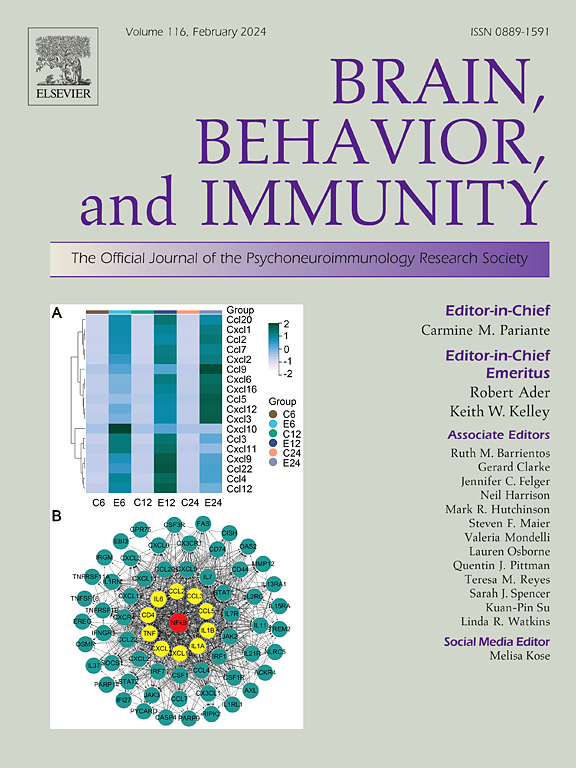Inflammation and psychomotor retardation in depression: The moderating role of glymphatic system
IF 8.8
2区 医学
Q1 IMMUNOLOGY
引用次数: 0
Abstract
Background
Psychomotor retardation (PMR) is a predominant symptom in patients with major depressive disorder (MDD). The relationship between inflammation and PMR is the subject of ongoing debate. The glymphatic system (GS) is a waste clearance system in the brain that interacts with the immune system. Herein, we hypothesized that GS function moderates the association between inflammation and PMR.
Methods
A total of 67 patients with MDD and 67 healthy controls (HCs) were recruited and underwent MRI scanning. PMR and inflammation, which were evaluated by measuring high-sensitivity C-reactive protein (hsCRP) levels in peripheral blood, were assessed in all patients. Diffusion tensor imaging analysis along the perivascular space was used to assess GS function. Functional connectivity (FC) and morphology within the motor circuit were also assessed. Moderation models were constructed to estimate the effect of GS function as a moderator of the relationships between hsCRP level and PMR and between hsCRP level and motor cortex FC and morphology.
Results
GS function in patients was impaired compared with that in HCs (t = –2.635, p = 0.009). Moderation models showed that hsCRP level significantly aggravated PMR severity at low levels of GS function, whereas this effect was negligible in patients with optimal GS function (F = 6.725, p = 0.021). GS function also exhibited a moderation effect on inflammation-related alterations in morphology (F = 13.86, p = 0.047) and FC (F = 13.765, p < 0.001) in the motor circuit.
Conclusion
A well-functioning GS mitigates inflammation-induced PMR and protects neurons from inflammatory damage. Given its moderating effect, GS function may play a crucial role in MDD psychopathology, and targeting GS function may have therapeutic value as an MDD treatment strategy.
炎症与抑郁症的精神运动迟缓:淋巴系统的调节作用。
背景:精神运动迟缓(PMR)是重度抑郁症(MDD)患者的主要症状。炎症和PMR之间的关系一直是争论的主题。淋巴系统(GS)是大脑中与免疫系统相互作用的废物清除系统。在此,我们假设GS功能调节炎症和PMR之间的关联。方法:共招募67例重度抑郁症患者和67例健康对照(hc)进行MRI扫描。通过测量外周血中高敏c反应蛋白(hsCRP)水平来评估所有患者的PMR和炎症。沿血管周围空间扩散张量成像分析评估GS功能。功能连接(FC)和形态学内的运动电路也进行了评估。构建调节模型来评估GS功能在hsCRP水平与PMR、hsCRP水平与运动皮质FC和形态学之间的调节作用。结果:与hc组相比,患者GS功能受损(t = -2.635,p = 0.009)。调节模型显示,在GS功能较低的患者中,hsCRP水平显著加重了PMR的严重程度,而在GS功能最佳的患者中,这种影响可以忽略不计(F = 6.725,p = 0.021)。GS功能对炎症相关形态学改变(F = 13.86,p = 0.047)和FC (F = 13.765,p )也有调节作用。结论:功能良好的GS可减轻炎症诱导的PMR,保护神经元免受炎症损伤。鉴于其调节作用,GS功能可能在MDD精神病理中起着至关重要的作用,针对GS功能作为MDD的治疗策略可能具有治疗价值。
本文章由计算机程序翻译,如有差异,请以英文原文为准。
求助全文
约1分钟内获得全文
求助全文
来源期刊
CiteScore
29.60
自引率
2.00%
发文量
290
审稿时长
28 days
期刊介绍:
Established in 1987, Brain, Behavior, and Immunity proudly serves as the official journal of the Psychoneuroimmunology Research Society (PNIRS). This pioneering journal is dedicated to publishing peer-reviewed basic, experimental, and clinical studies that explore the intricate interactions among behavioral, neural, endocrine, and immune systems in both humans and animals.
As an international and interdisciplinary platform, Brain, Behavior, and Immunity focuses on original research spanning neuroscience, immunology, integrative physiology, behavioral biology, psychiatry, psychology, and clinical medicine. The journal is inclusive of research conducted at various levels, including molecular, cellular, social, and whole organism perspectives. With a commitment to efficiency, the journal facilitates online submission and review, ensuring timely publication of experimental results. Manuscripts typically undergo peer review and are returned to authors within 30 days of submission. It's worth noting that Brain, Behavior, and Immunity, published eight times a year, does not impose submission fees or page charges, fostering an open and accessible platform for scientific discourse.

 求助内容:
求助内容: 应助结果提醒方式:
应助结果提醒方式:


